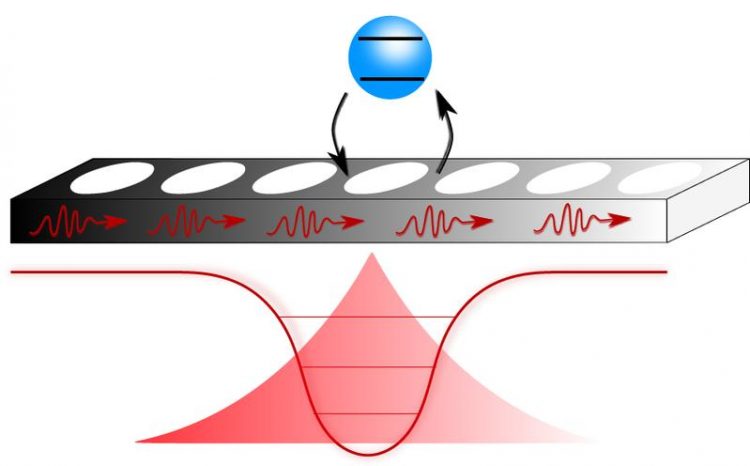One impurity to bind them all

Illustration of the trapping process: a two-level atomic impurity is localized in a periodic structure. Because the atomic frequency lies in the bandgap of the material the photons that are released after excitation of the atom are trapped inside the structure. Graphic: MPQ, Theory Division
Nobody is perfect, but sometimes it is the defect that makes the difference. For example, the electric properties of semiconductors undergo significant changes by the slightest variation in the dopant concentration, and though a perfect diamond is without any colour, atomic impurities make them shine in pale blue, violet or pink which even enhances their value.
All these effects go back to processes that are triggered by the interaction of the impurity with the quantum many-body system it is embedded in. A team of physicists in the Theory Division of Prof. Ignacio Cirac at the Max Planck Institute of Quantum Optics (MPQ) has now investigated the more general case where an impurity atom is coupled to a structured bath of bosons (for example, photons in a periodically engineered dielectric) showing how a single atom can bind many bosons around it.
Bound states of bosons are of particular interest because they give rise to long and strong interactions enabling new regimes for quantum simulations. (Phys. Rev. X 6, 021027 (2016), 25 May 2016).
The interaction of spin impurities with bosonic reservoirs lies at the heart of very paradigmatic models in Quantum Optics and Condensed Matter and gives rise to very rich phenomena. For example, in the context of atoms coupled to engineered dielectrics, i.e., photonic crystals, it was predicted that a single atom can localize a single-photon cloud around it if the atomic frequency lies in the photonic bandgap of the material.
With the recent advances in interfacing atomic systems with photonic crystal structures, these atom-photon bound states have experienced a renewed interest in the context of quantum simulation as they have been proposed to mediate strong and long-range interactions between atoms.
In their newly published work, Tao Shi, Ying-Hai Wu and Alejandro González-Tudela from the Theory Division of Prof. Ignacio Cirac study the general problem of a single spin impurity coupled to a generic bosonic bath and show that a single atom can indeed trap not a single, but infinitely many bosons around it. Loosely speaking, the coupling of the impurity to the bath generates an effective potential to the bosons that is able to localize the bosons around it.
In particular, a single atom can localize a multi-photon cloud around it within a photonic crystal. Moreover, the authors also provide a variational description that allows them to describe their behaviour in all parameter space, unveiling the existence of many different regimes with different scaling of physical properties like the energy or the size of the bound states.
Due to the generality of the model, these bound states can potentially be prepared and observed in many different platforms, ranging from atoms coupled to photonic crystals to circuit QED or even cold atoms in state dependent optical lattices. The existence of these boson bound states spans the possibilities of these platforms to simulate new exotic many-body phenomena. [AGT/OM]
Original publication:
Tao Shi, Ying-Hai Wu, A. González-Tudela, and J. I. Cirac
Bound states in boson impurity models
Phys. Rev. X 6, 021027 (2016), 25 May 2016
Contact:
Prof. Dr. J. Ignacio Cirac
Honorary Professor TU Munich and
Director at Max Planck Institute of Quantum Optics
Hans-Kopfermann-Str. 1
85748 Garching, Germany
Phone: +49 (0)89 / 32 905 -705 /-736
Fax: +49 (0)89 / 32 905 -336
E-mail: ignacio.cirac@mpq.mpg.de
Dr. Alejandro González-Tudela
Max Planck Institute of Quantum Optics
Hans-Kopfermann-Str. 1
85748 Garching, Germany
Phone: +49 (0)89 / 32 905 -127
E-mail: alejandro.gonzalez-tudela@mpq.mpg.de
Dr. Olivia Meyer-Streng
Press & Public Relations
Max Planck Institute of Quantum Optics
Phone: +49 (0)89 / 32 905 -213
E-mail: olivia.meyer-streng@mpq.mpg.de
Media Contact
More Information:
http://www.mpq.mpg.de/All latest news from the category: Physics and Astronomy
This area deals with the fundamental laws and building blocks of nature and how they interact, the properties and the behavior of matter, and research into space and time and their structures.
innovations-report provides in-depth reports and articles on subjects such as astrophysics, laser technologies, nuclear, quantum, particle and solid-state physics, nanotechnologies, planetary research and findings (Mars, Venus) and developments related to the Hubble Telescope.
Newest articles

High-energy-density aqueous battery based on halogen multi-electron transfer
Traditional non-aqueous lithium-ion batteries have a high energy density, but their safety is compromised due to the flammable organic electrolytes they utilize. Aqueous batteries use water as the solvent for…

First-ever combined heart pump and pig kidney transplant
…gives new hope to patient with terminal illness. Surgeons at NYU Langone Health performed the first-ever combined mechanical heart pump and gene-edited pig kidney transplant surgery in a 54-year-old woman…

Biophysics: Testing how well biomarkers work
LMU researchers have developed a method to determine how reliably target proteins can be labeled using super-resolution fluorescence microscopy. Modern microscopy techniques make it possible to examine the inner workings…





















